Background and Overview
Healthcare systems often overlook the perspectives of patients, families, and frontline providers, despite strong evidence that these voices are central to safe and respectful care. Genuine co-production requires moving beyond surface-level consultation to true partnership, where patients define what quality means in practice and providers work alongside them to deliver it.
The quality journey in healthcare is often described as progressing through distinct stages. The first stage, Quality 1.0, focuses on establishing standards and accreditation systems. These frameworks, such as national star ratings or international accreditations, provide an essential baseline by defining what safe and effective care should look like. However, accreditation alone is not a guarantee of consistent quality. It may demonstrate excellence on the day of inspection, but sustaining that performance requires more than compliance. Standards remain important as a foundation, but they represent a starting point rather than an endpoint in the pursuit of quality.
The second stage, Quality 2.0, emphasizes continuous improvement. This stage moves beyond merely meeting standards to systematically strengthening reliability, reducing variation, and embedding practices that ensure safe and effective care is delivered consistently. It involves building systems that are not only compliant but also resilient and adaptive to changing conditions.
The third stage, Quality 3.0, focuses on co-production of health, where patients, families, and providers work as equal partners in designing and delivering care. This stage builds on earlier progress by centering healthcare around shared values; kindness, compassion, dignity, respect, integration, and partnership. Surrounding these values are leadership and resilience, including openness to learning and transparency. Together, these principles reframe quality as not only the absence of harm but also the creation of trust, partnership, and meaningful human connection in healthcare.
Safety and quality must extend across the entire continuum of care, from the smallest rural dispensary to the most advanced tertiary hospital. Every touchpoint in a patient’s journey matters; gaps at any stage erode trust and increase risk. At the same time, the lived experience of health workers must be addressed. Feelings of powerlessness, alienation, and burnout are widespread and directly linked to higher levels of harm. Building a culture of belonging, teamwork, and shared purpose is therefore as critical to safety as technical interventions.
A key distinction in healthcare lies between offering a product and offering a service. Products, such as a surgical procedure or laboratory test, are technical outputs delivered to meet an immediate clinical need. Services, by contrast, involve the relational and emotional dimensions of care; listening, explaining, reassuring, and showing respect to patients and families. Safe, high-quality care requires both: the reliable delivery of products alongside the compassionate service that surrounds them. Neglecting either diminishes the patient experience and weakens trust in the system.
Storytelling is a vital mechanism in this process. Patients come with their story; a narrative shaped by needs, preferences, and lived realities. Too often, this is reduced into a medical “history” owned by professionals, stripping away meaning and agency. Reframing these narratives as our story, shared between patient and provider, transforms care into a collaborative act. Listening deeply, acknowledging perspectives, and reflecting together bridge the gap between technical care and human connection. This narrative approach anchors safety in empathy and ensures that improvement efforts remain people-centered, sustainable, and kind.
Key Themes
A vision for kindness in healthcare begins with clarity about what a truly kind service looks like. Kindness is not abstract; it is embodied in values such as empathy, collaboration, personalization, patience, listening, and being fully present. Empathy requires providers to enter into the experiences of patients, while collaboration emphasizes working together as partners rather than in hierarchies. Personalization acknowledges that every individual’s story is unique, and being present demands full attention and psychological safety. Together, these qualities create care that is safe, effective, and deeply human.
Inclusiveness strengthens this vision by ensuring that patients, families, and providers can participate fully in the care process. Too often, healthcare relies on technical jargon and acronyms that exclude those it seeks to serve. Inclusiveness calls for adapting communication to the patient’s level of understanding, whether through plain language, translation into local dialects, or tailoring information to different levels of health literacy. It also extends to designing services that are accessible for vulnerable groups such as the elderly, disabled, or those with limited education. By making engagement easy and meaningful, inclusiveness transforms healthcare into a more equitable and participatory process.
Kindness itself must be understood as more than sentiment; it is a deliberate, strategic force that sustains cooperation and collaboration. Acts of kindness generate reciprocity, encouraging attentiveness, alignment with context, and trust. This virtuous circle strengthens both safety and quality. Kindness can manifest in “mango moments”; small but profound gestures that bring comfort, recognition, or support to patients and colleagues. Yet, barriers such as high workloads, burnout, or cultures that prioritize efficiency over empathy often stand in the way. Recognizing kindness as a core component of safe care, rather than an optional extra, is key to overcoming these challenges.
Respect is another cornerstone of safe and kind care. It means honoring the dignity and worth of every individual, whether a patient, family member, or healthcare worker. Respect goes beyond courtesy, requiring active listening, valuing diverse perspectives, and acknowledging contributions across the care team. When patients feel respected, they are more willing to share openly, while healthcare workers who experience respect are empowered to innovate and collaborate. Respect, therefore, is not simply relational but foundational to trust and safety.
Courage is equally essential, because practicing kindness often involves risk. It takes bravery to speak up about unsafe practices, admit mistakes, or challenge entrenched hierarchies. Courage is also evident in moments of vulnerability; asking for help, acknowledging limits, or showing compassion in high-pressure situations. By modeling courageous kindness, healthcare workers dismantle cultures of fear and blame, replacing them with environments that foster openness and safety.
Humility keeps care grounded by recognizing that no single role or perspective holds all the answers. In systems where authority often favors doctors or senior staff, humility ensures that the knowledge of nurses, technicians, and patients is equally valued. It fosters collaboration over hierarchy and creates space for shared decision-making. Humility allows care to be guided by respect and inclusiveness, strengthening the collective effort toward safety and quality.
Transparency builds on these values by fostering honesty and openness across all levels of care. It is not limited to accurate documentation but extends to communication, acknowledging challenges, risks, and limitations with clarity. Transparency requires courage and humility, but it establishes the trust necessary for accountability and for co-producing care. When patients and colleagues are included in the truth, even when it is uncomfortable, they can engage more meaningfully in solutions.
Justice and equity bring a systemic dimension to kindness. It is not enough for individuals to act with fairness; health systems themselves must address inequities that determine who receives safe, high-quality care. Universal access alone does not guarantee equity; variations in geography, infrastructure, or socioeconomic status can still create disparities. True justice demands the removal of structural barriers and the design of systems that deliver dignity, safety, and quality consistently across all contexts.
Co-production embodies the spirit of Ubuntu: “I am because we are.” It recognizes that patients and providers are partners in shaping health outcomes, not actors on opposing sides. Co-production requires courage, humility, transparency, and respect, while asking patients to contribute their voices and experiences despite vulnerability. By moving beyond transactional models of care, co-production creates shared ownership, trust, and solutions that are more responsive and sustainable. It is the culmination of all the other themes; kindness, inclusiveness, respect, and justice, woven into collaborative action for safer care.
Post-Presentation Discussions
The discussions highlighted several important takeaways about embedding kindness in healthcare. A recurring theme was the power of presence; being fully attentive to patients and colleagues rather than distracted by other demands. Presence was described as the starting point for trust and connection, addressing one of the most common complaints from patients: that providers seem physically present but mentally elsewhere.
Another strong message was that kindness must be intentional. In overstretched systems where a single provider may see dozens of patients in a day, kindness cannot be left to chance. It requires conscious effort, whether through empathetic communication, respectful acknowledgment of time constraints, or small gestures such as a reassuring touch. Participants emphasized that even in the busiest environments, patients can feel valued if providers take the time to listen, explain, and connect. Ultimately, kindness was framed as a non-negotiable part of care, something that costs nothing yet has the power to transform experiences for both patients and providers.
Building Cultures of Kindness in Healthcare
The conversation on quality and safety is evolving from technical compliance toward values that humanize care. Kindness, inclusiveness, respect, humility, transparency, justice, and co-production are no longer optional ideals; they are essential elements for safe, high-quality care.
The challenge ahead is sustaining these values in overstretched systems where burnout, resource constraints, and entrenched hierarchies often work against them. Embedding kindness as intentional practice, ensuring inclusiveness in communication and design, and addressing systemic inequities will require courage and leadership at every level. If embraced, these principles can transform healthcare from a service that simply treats disease into one that co-creates safer, fairer, and more deeply human health.
FOR FURTHER READING
- Batalden, P., et al. (2016). Coproduction of healthcare service. BMJ Quality & Safety, 25(7), 509–517.
- Greco A, González-Ortiz LG, Gabutti L, Lumera D. What’s the role of kindness in the healthcare context? A scoping review. BMC Health Serv Res. 2025 Feb 5;25(1):207. doi: 10.1186/s12913-025-12328-1. PMID: 39910597; PMCID: PMC11796266.
- Batalden, Paul & Lachman, Peter & von Plessen, Christian & Johnson, Julie & Garcia Elorrio, Ezequiel. (2023). Coproduction of healthcare services-from concept to implementation. International journal for quality in health care : journal of the International Society for Quality in Health Care. 35. 10.1093/intqhc/mzad083.
- Robert, G., Donetto, S., Masterson, D., & Kjellström, S. (2020). Applying models of co-production in the context of health and well-being: Int J Qual Health Care. 2024 Aug 28;36(3):mzae077. doi: 10.1093/intqhc/mzae077. PMID: 39120968; PMCID: PMC11352599.
- American Geriatrics Society Expert Panel on Person-Centered Care. Person-Centered Care: A Definition and Essential Elements. J Am Geriatr Soc. 2016 Jan;64(1):15-8. doi: 10.1111/jgs.13866. Epub 2015 Dec 2. PMID: 26626262..
Key Session Highlights
Kindness as a Strategic Force
Real-time polling confirmed that fear of punishment is still the biggest obstacle to incident reporting across African health systems.
Inclusiveness Breaks Down Barriers
South Africa’s journey showed that national reporting systems succeed only with strong leadership commitment and phased, collaborative implementation.
Humility Enables Shared Ownership
Countries like Kenya and Ghana have patient safety policies or forms in place, but uptake remains weak without cultural change and enforcement.
Justice and Equity as System Priorities
Kenya’s hospital-level experience with anonymous digital reporting demonstrated that staff are more willing to report when protected from blame.
Storytelling as a Bridge
Nigeria illustrated the challenge of multiple agencies handling reports; efforts to unify systems are key to reducing duplication and gaps.
Co-Production as the Culmination of Values
The spirit of Ubuntu embodies co-production. By weaving kindness, inclusiveness, respect, courage, humility, and transparency into shared action, patients and providers become partners in safer, more human healthcare.
Feedback from participants
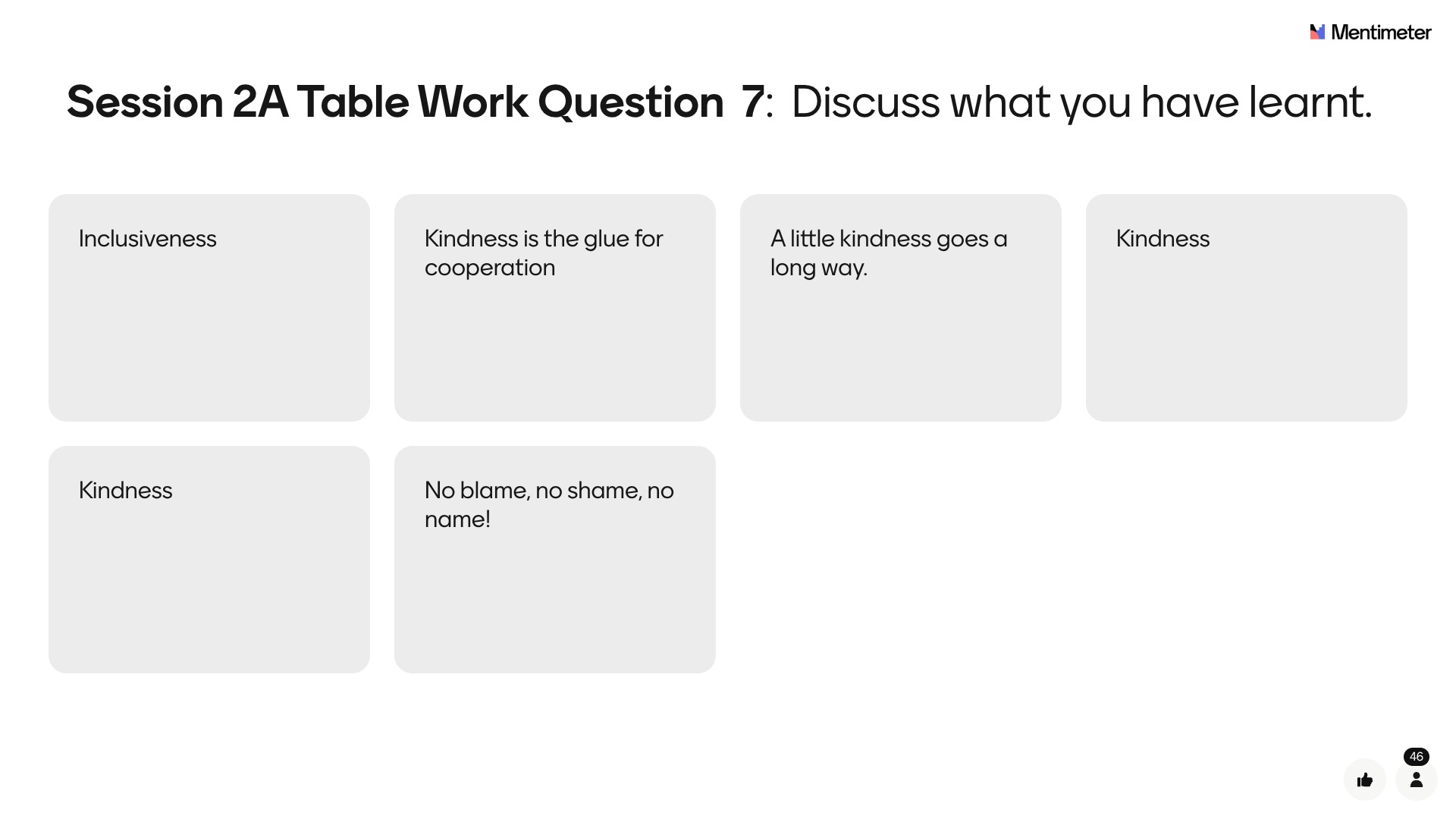
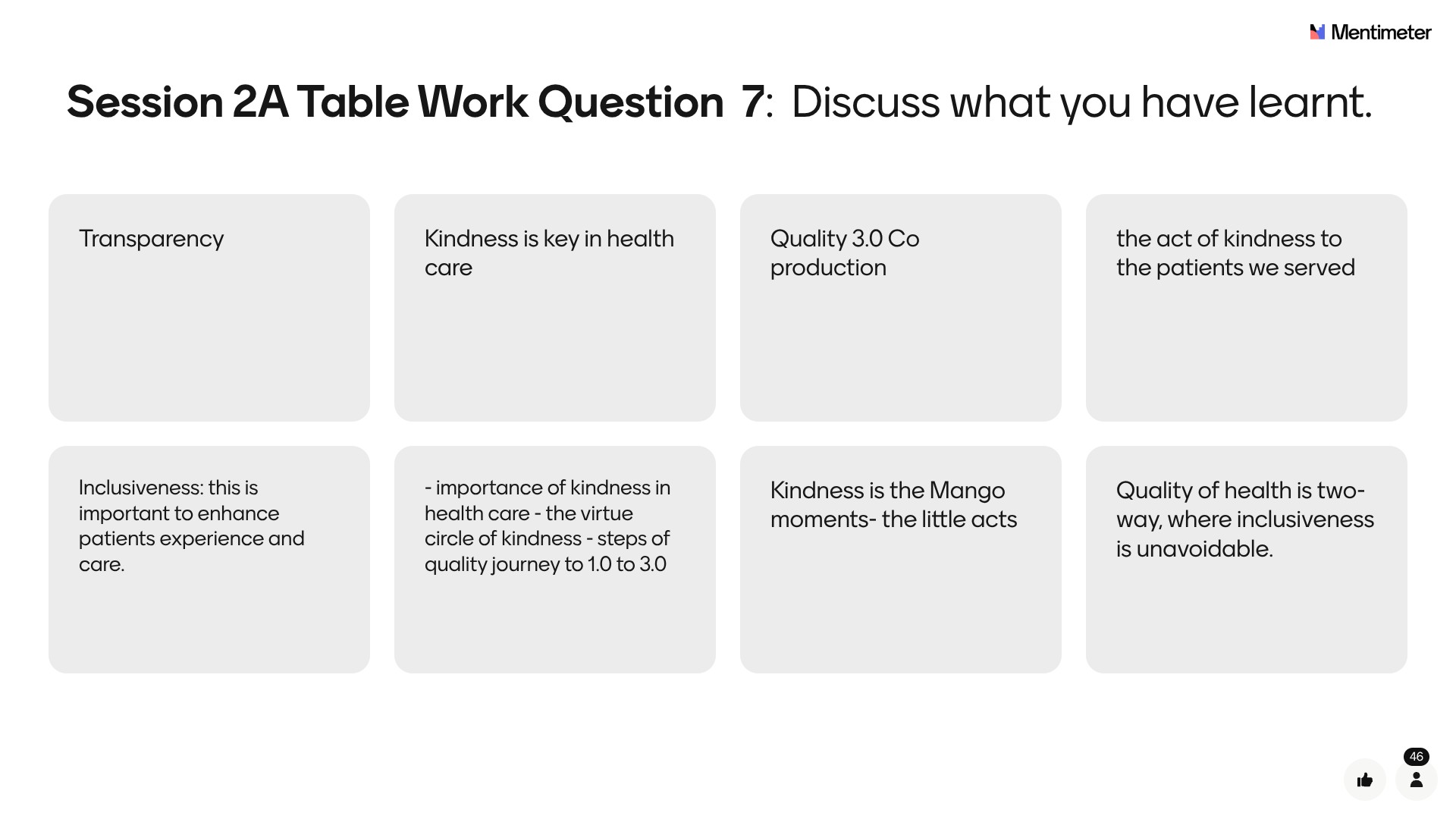
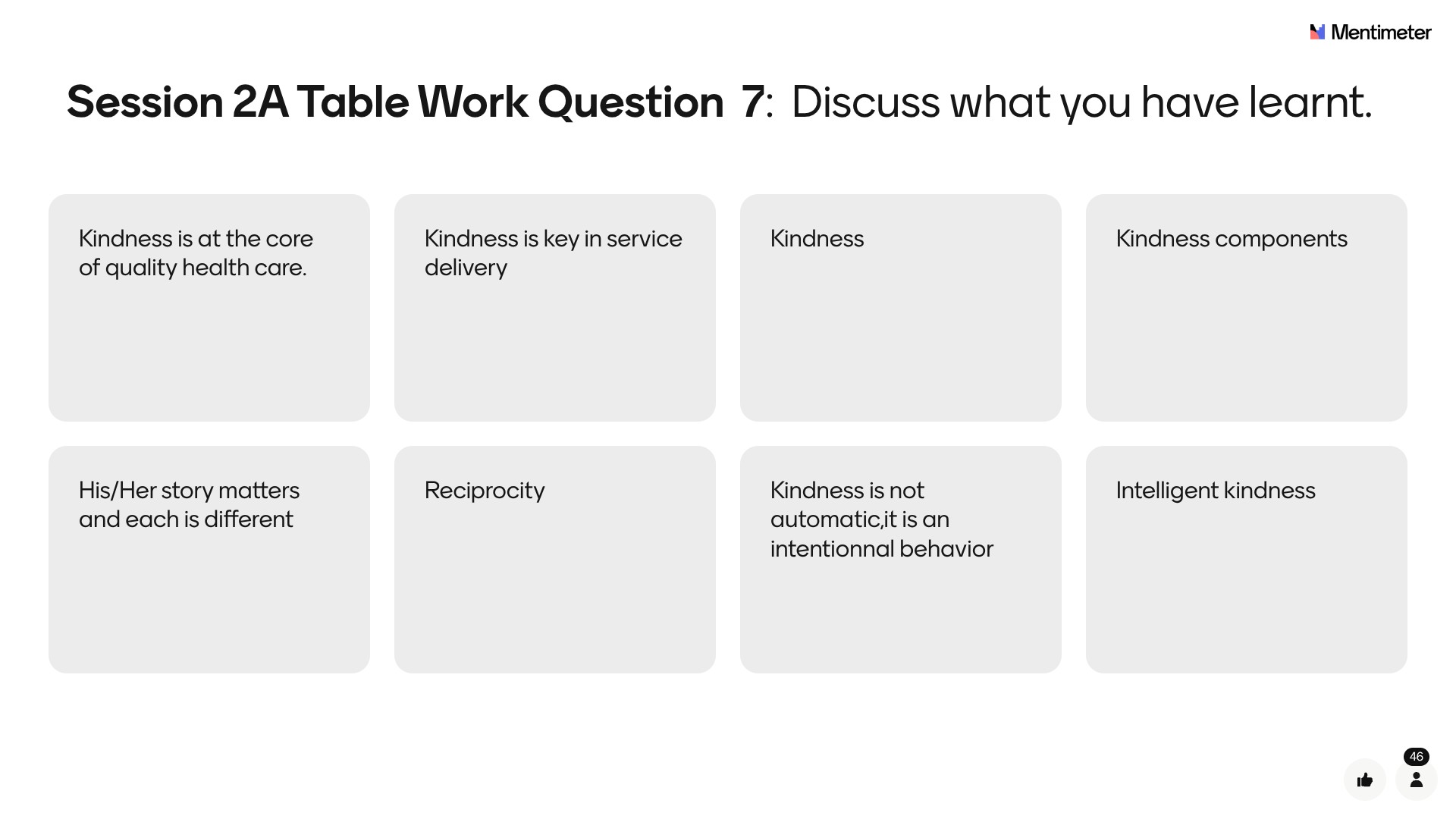
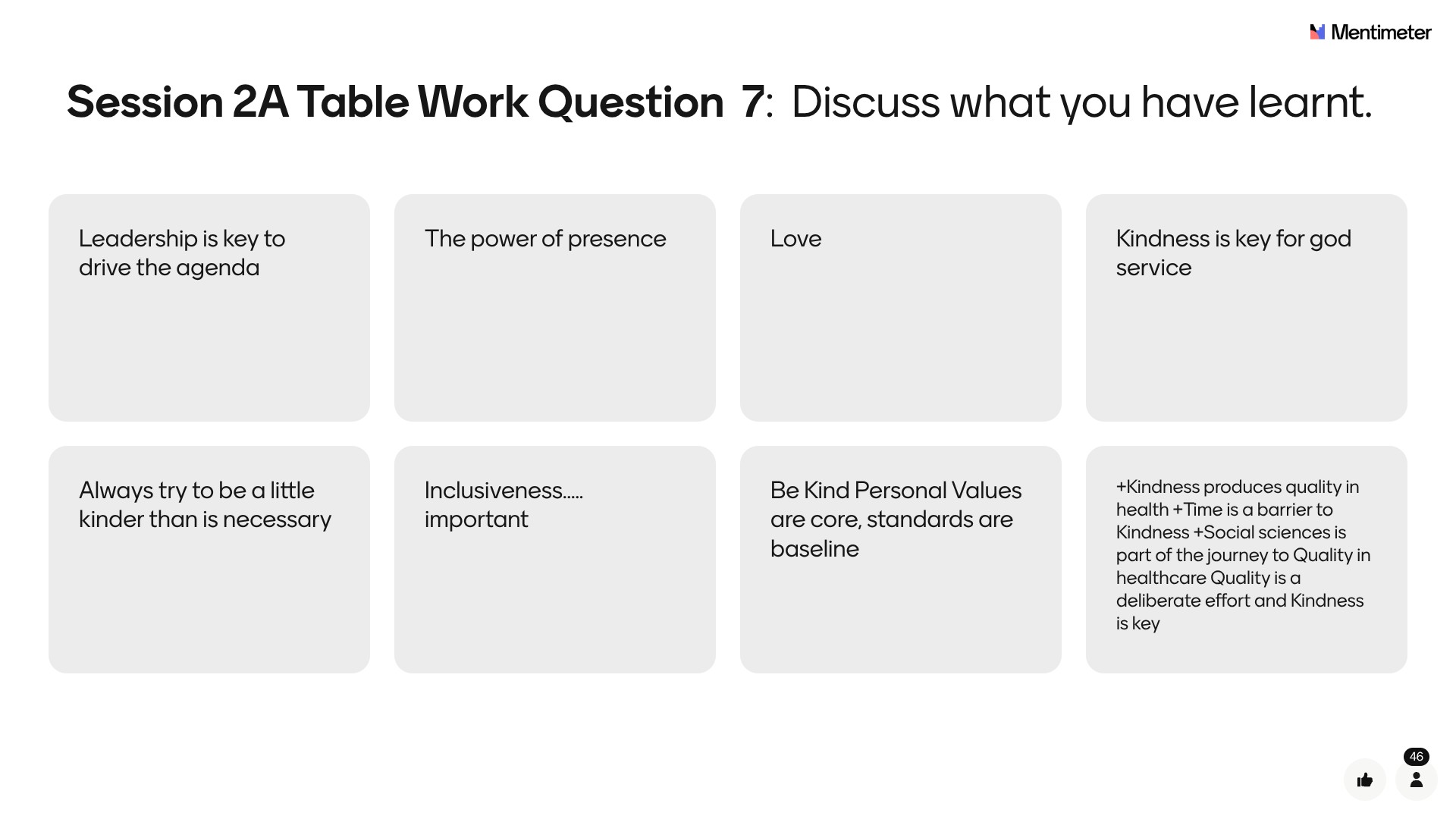
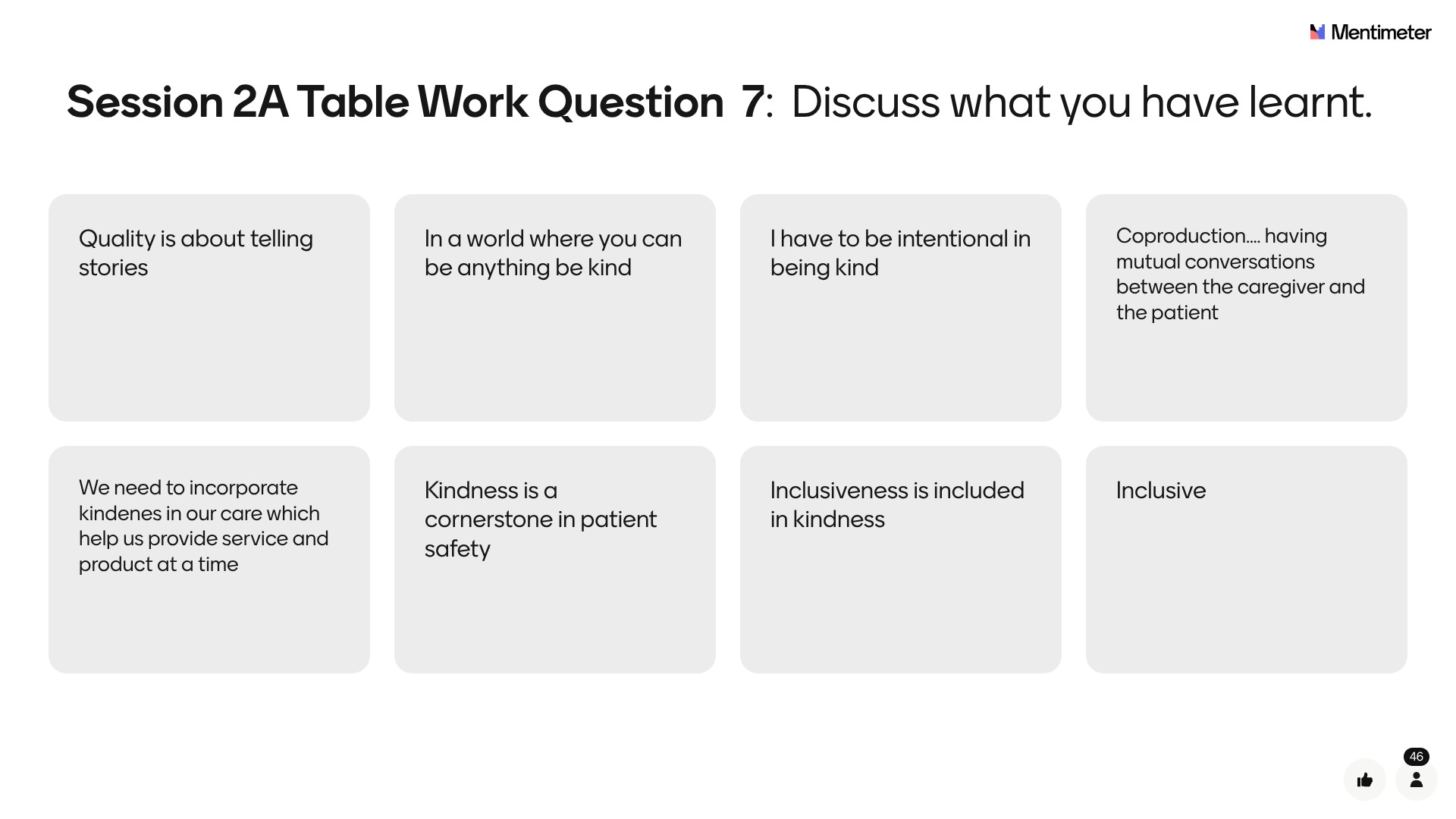
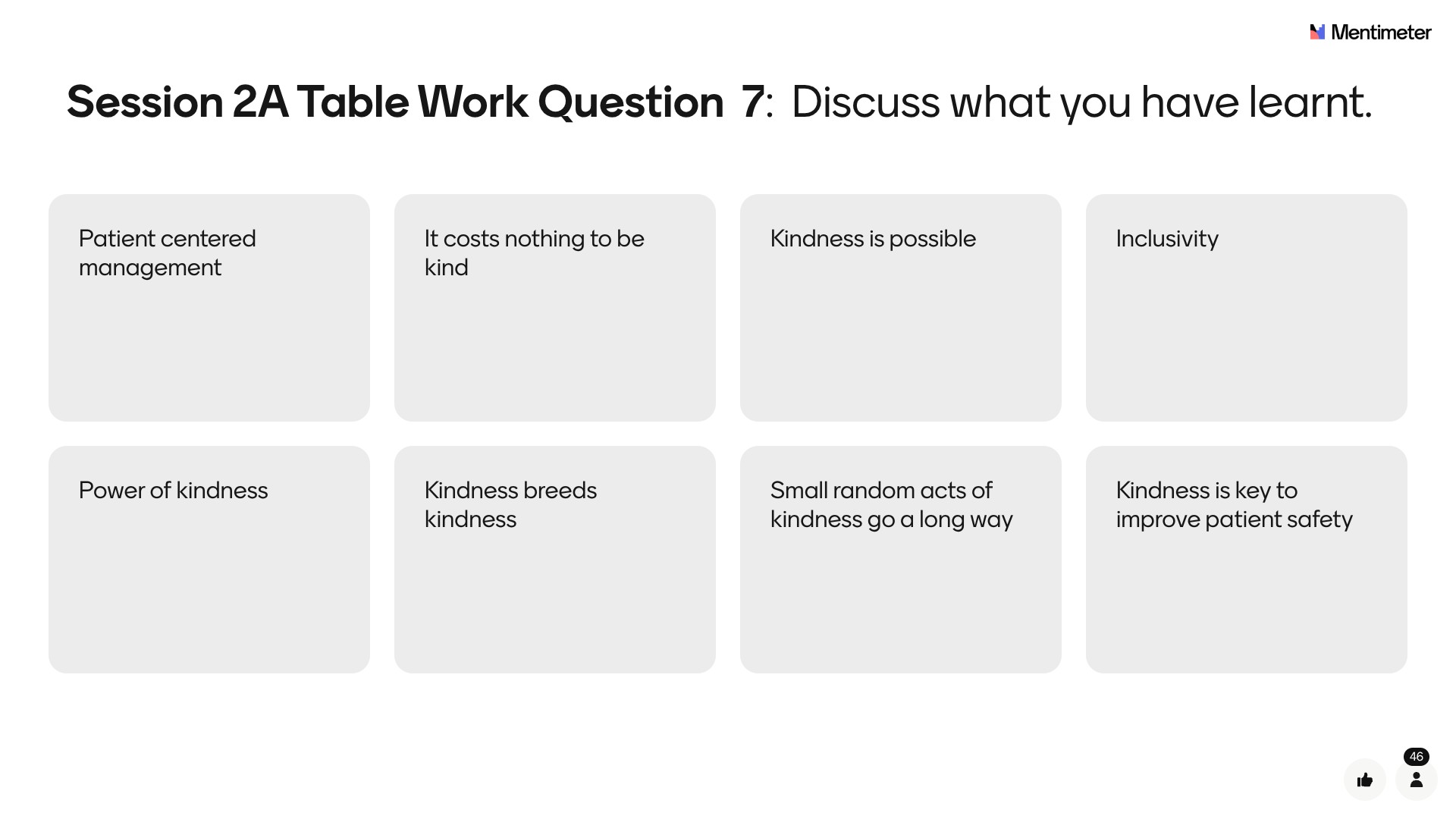
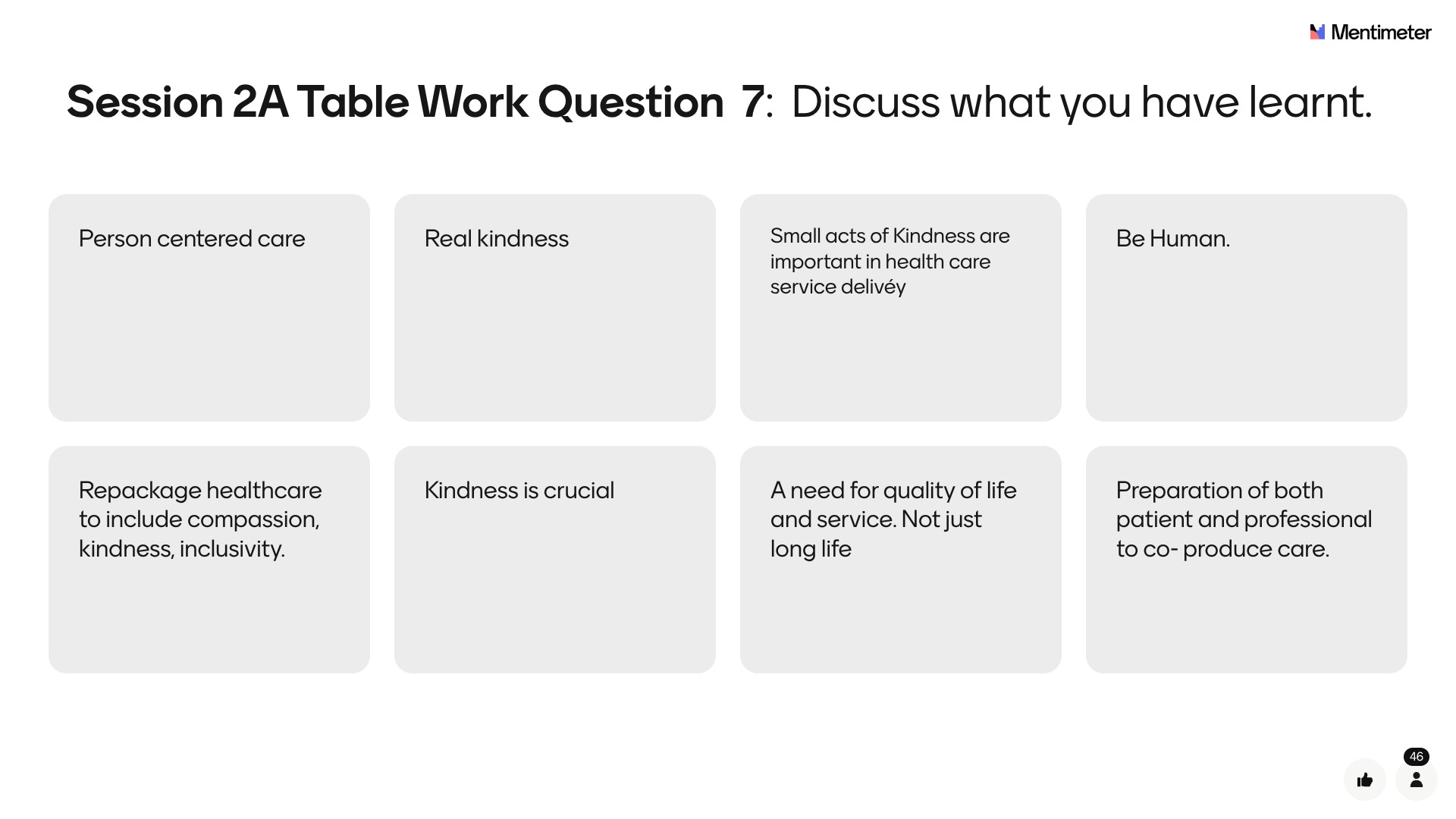
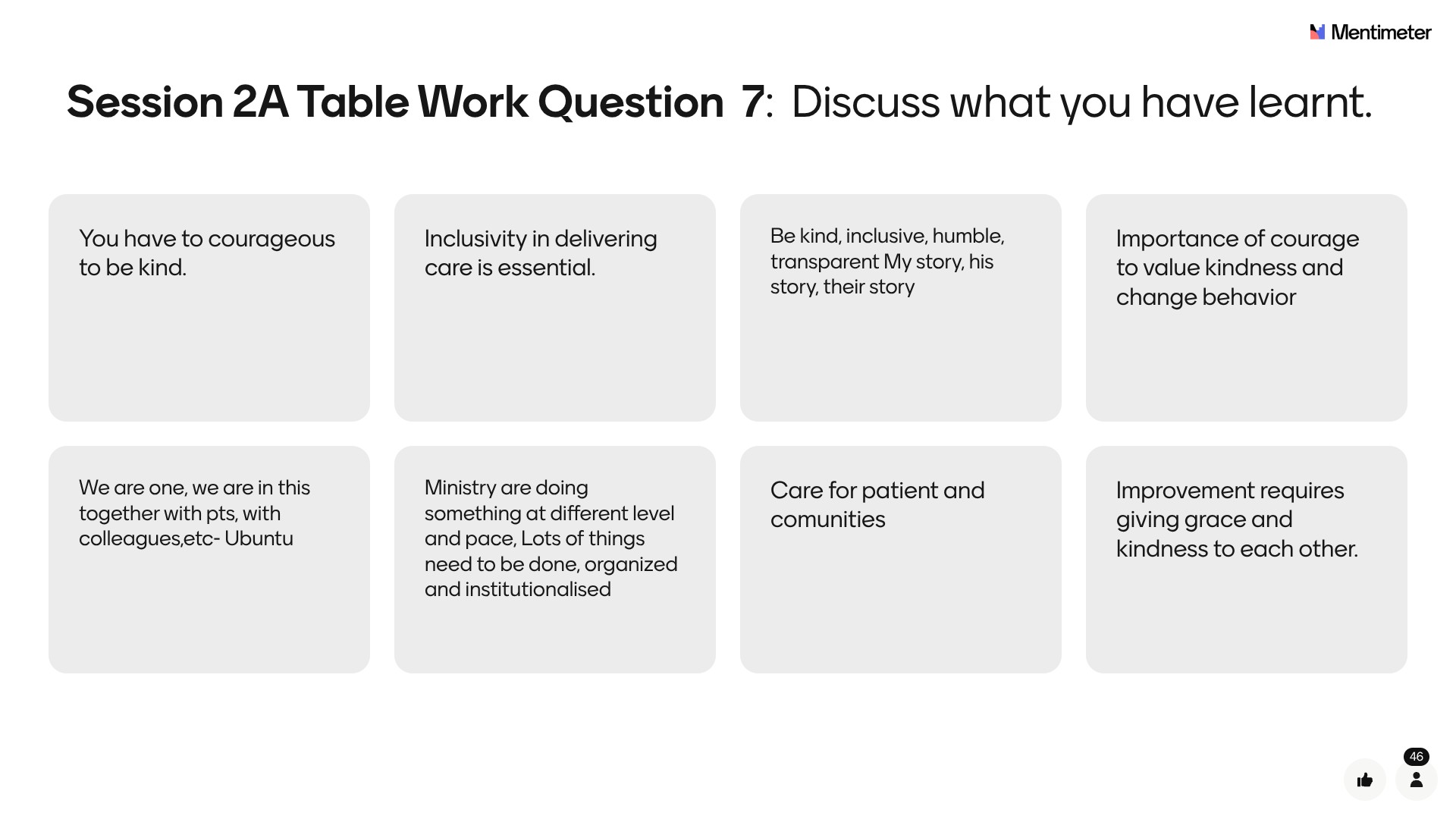
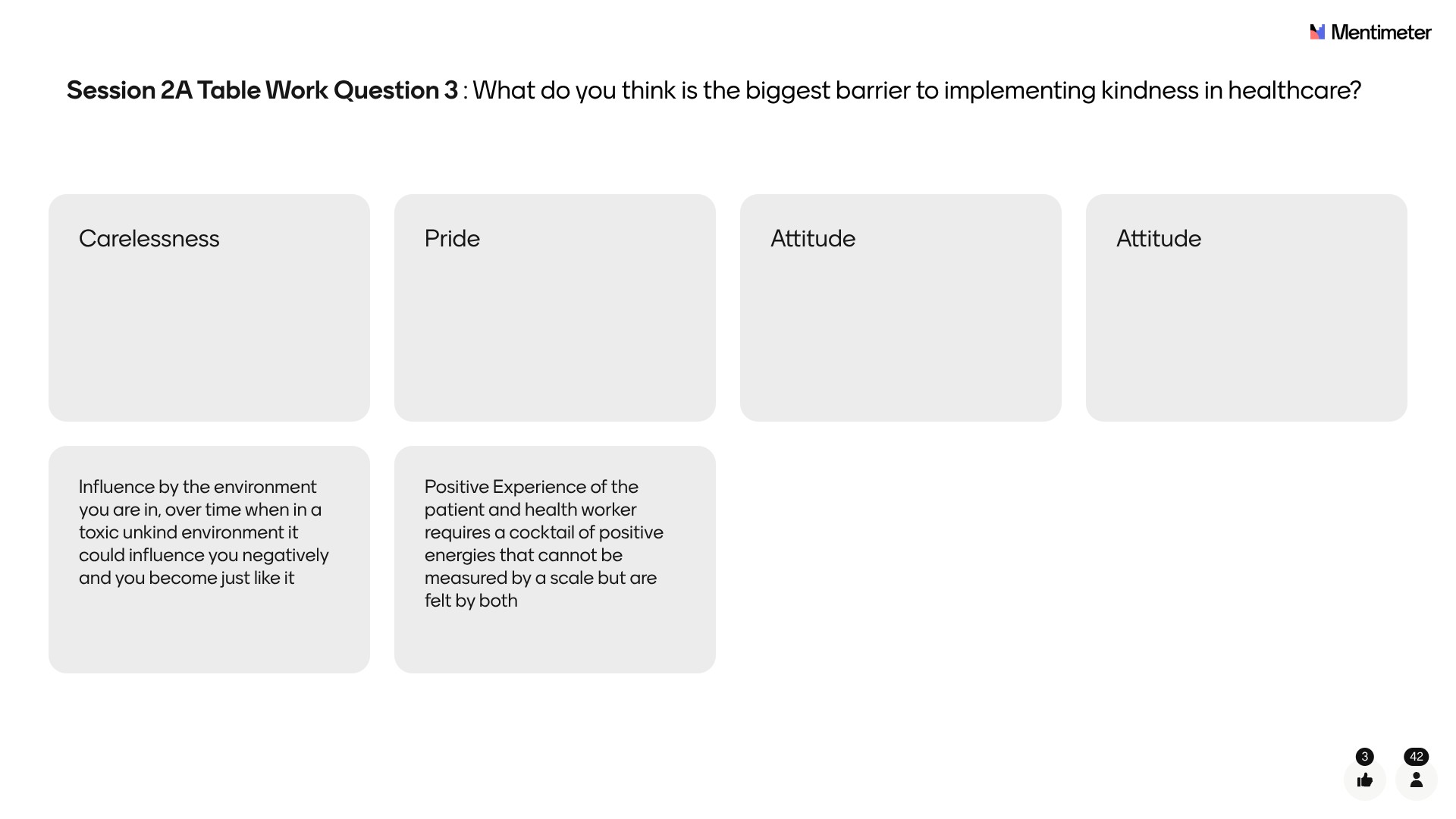
quotes from the keynote speaker
Key Session Takeaways
Quality and safety start with understanding people’s lived experiences. True improvement begins where people live and receive care, shaping systems that reflect real needs and contexts.
Key Takeaways
- Quality care begins at the community level, not only within hospitals.
- Understanding people’s lived environments is essential to design relevant health interventions.
- Healthcare quality must balance patient, workforce, and community experiences
Quality healthcare requires balancing both product (the technical delivery of care) and service (the human connection and empathy that surround it). True excellence lies in knowing when to provide each, and how to integrate both for safe, compassionate care
Key Takeaways
Healthcare combines both service (relationships and empathy) and product (clinical care and procedures).
Recognizing when to emphasize each is vital for holistic patient experiences.
Balanced care strengthens trust between patients, families, and providers.
Creating a shared story in healthcare means recognizing that a patient’s story doesn’t belong to the provider alone. It’s built through listening, reflection, and transparency.
Key Takeaways
- Quality care begins with truly listening to patients and valuing their experiences.
- Documentation should reflect shared understanding, not ownership of the patient’s story.
- Transparency builds trust and accountability in the care process.
The new multidimensional quality model highlights seven interconnected domains of care, with person-centeredness at its core. It emphasizes values like compassion, dignity, respect, and partnership; supported by leadership, resilience, and continuous learning.
Key Takeaways
Quality care is multidimensional, built on both values and systems.
Person-centeredness should guide all aspects of healthcare delivery.
Resilience enables healthcare teams to adapt and sustain quality over time.
The status of patient safety incident reporting in Africa was explored, and while awareness is growing, gaps remain in policy, reporting culture, and EHR adoption. Yet, positive signs from institutional polls show progress is underway.
Key Takeaways
Kind service incorporates empathy; understanding and valuing each patient’s unique experience.
Collaboration among healthcare teams enhances compassionate, coordinated care.
Personalized care respects individual stories and needs.
Inclusive care is about ensuring everyone feels seen, heard, and involved. From using simple language to engaging patients and communities in service design, inclusivity in healthcare starts with empathy, communication, and shared understanding.
Key Takeaways
Inclusivity in healthcare requires actively involving patients and communities in service design.
Clear, simple language promotes understanding and participation for all.
Services must be accessible to people with disabilities, the elderly, and the mentally challenged.
“Mango moments” remind us that small, thoughtful gestures; listening, asking, or offering help can transform patient and staff experiences, making healthcare more compassionate and human.
Key Takeaways
Healthcare quality is not just technical; it’s deeply human, rooted in simple, genuine care.
Small acts of kindness can have lasting emotional impact on patients and colleagues.
Compassion and empathy are essential components of quality care.
Live Recording, Speakers and Panelists
Strengthening Incident Reporting Systems to Advance Patient Safety in Africa

At ACQUIRE, we believe that kindness, inclusiveness, and co-production are essential to building safer, more trusted health systems. We invite you to share your stories, reflections, or practical examples of how you are embedding kindness and respect in healthcare. Together, we can turn small acts into systemic change and create care that is safer, fairer, and more human.
Join us in working towards more responsive, data-led health systems across Africa.
Email us: [email protected]
Connect with us on our social media platforms:

